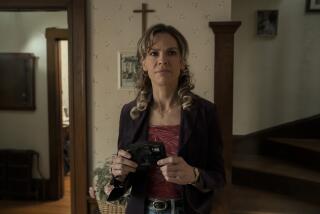Movie review: ‘Rejoice and Shout’
If you don’t know gospel music, really know it, you are missing out on a lot, but don’t lose faith. “Rejoice and Shout,” a vibrant and comprehensive new documentary will take you there in style.
Directed by Don McGlynn, who had access to producer Joe Lauro’s huge 10,000-hour collection of American music on film and video, “Rejoice” provides both a melodic education and a once-in-a-lifetime concert in one soul-stirring package.
“Rejoice and Shout” not only has the music, it has strong interviews with top gospel authorities such as Anthony Heilbut, Bill Carpenter and Jacquie Gales Webb, plus incisive comments by headliner gospel singers like Mavis Staples of the breakout Staple Singers and Ira Tucker, who joined the Dixie Hummingbirds in 1938 at age 13 and stayed for 70 years.
Before getting to the music proper, “Rejoice” is careful to place it in its religious context. For gospel can’t be separated from its connection to the biblical injunction to “make a joyful noise unto the Lord.”
A key element in this is the influence on African American churchgoers of the Pentecostal tradition, which encouraged congregants to participate fully in church services. One of the strengths of “Rejoice” is its newsreel footage of such celebrated ministers as Sweet Daddy Grace and Elder Solomon Lightfoot Michaux as well as scenes of worshippers lost in ecstatic fervor.
“Rejoice” introduces its music chronologically, allowing us to hear how one style of singing led to another. It has also made the wise decision to allow these songs to play out as much as possible, so we can experience performances in their entirety.
The first gospel recording we hear is a 1902 disc of the Dinwiddie Colored Quartet, recorded decades before any jazz or blues music, a group that sounds like a barbershop quartet. It fell to Thomas A. Dorsey, composer of classics like “Precious Lord Take My Hand,” to fully bring the sound of the South into gospel.
One of gospel’s strengths was that it offered a home for strong female singers, starting in the 1930s with Sister Rosetta Tharpe, one of the first women to both play guitar and preach. “Rejoice” not only has clips of her, it features a pungent interview with the redoubtable Marie Knight, who toured with Sister Rosetta back in the day.
The biggest of gospel’s solo singers was Mahalia Jackson, whose “Move Up a Little Higher” sold 2 million copies in 1946, a time when 20,000 copies was considered a hit. A major highlight of the film is Jackson in her prime singing “These Are They” on “The Ed Sullivan Show” and displaying what Anthony Heilbut calls “the voice that wrecked churches in Chicago.”
Male groups were the other dominant gospel trend, and “Rejoice and Shout” features knockout segments of both the Dixie Hummingbirds and the Swan Silvertones performing at the Newport Jazz Festival. The Hummingbirds pioneered having two lead singers trading riffs, while the Silvertones had the benefit of singer Claude Jeter’s exquisite falsetto.
Clearly made by people who love the music, “Rejoice” also features some memorable clips — Brother Joe May and Jackie Verdell tearing through “You Gonna Need Him” and a young member of the Selvey Family doing a killer “Amazing Grace” — that don’t fit in any historical continuum. They’re just there because they can’t be resisted. Amen to that.
More to Read
The biggest entertainment stories
Get our big stories about Hollywood, film, television, music, arts, culture and more right in your inbox as soon as they publish.
You may occasionally receive promotional content from the Los Angeles Times.







